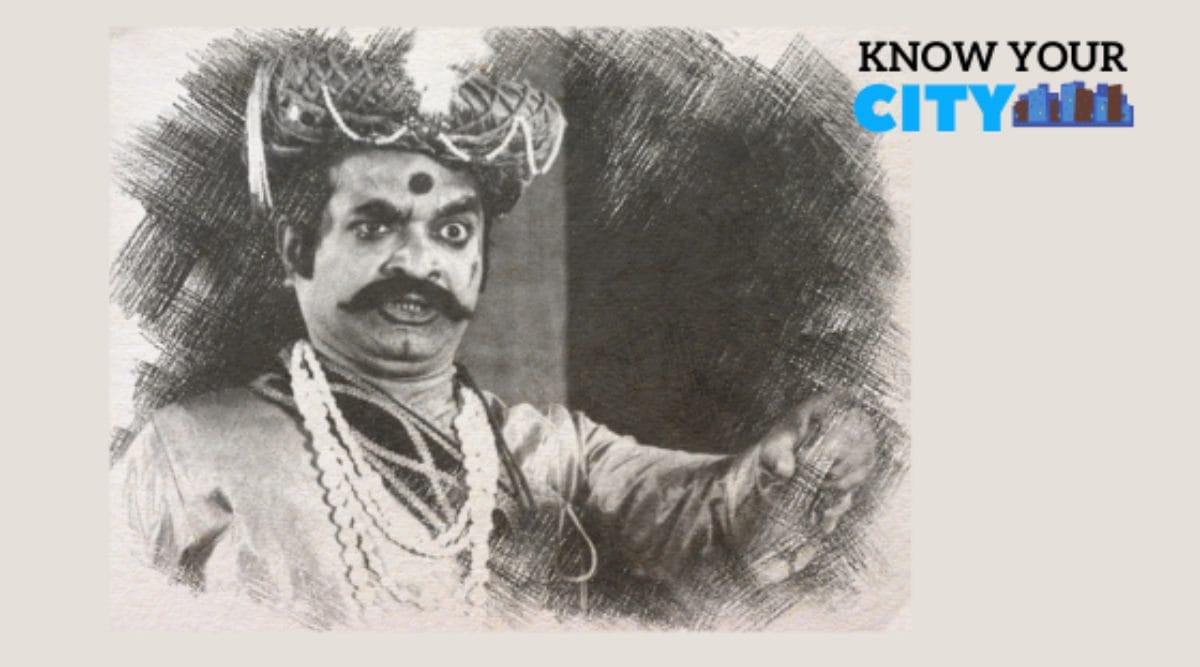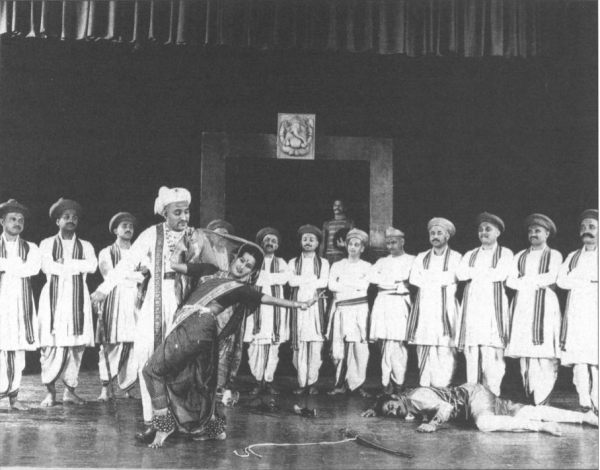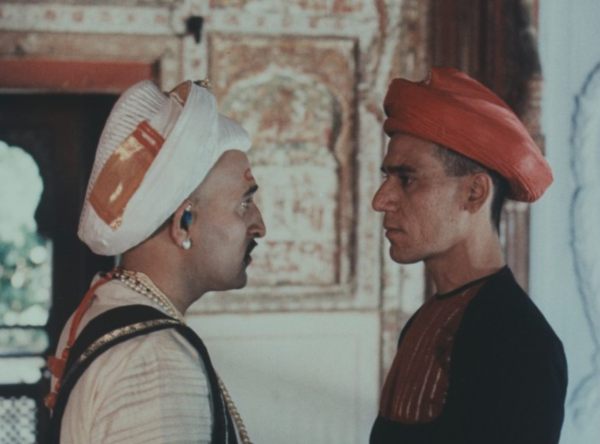 Ghashiram was played by Ramesh Tilekar in Theatre Academy's production of Vijay Tendulkar's Ghashiram Kotwal (1973).
Ghashiram was played by Ramesh Tilekar in Theatre Academy's production of Vijay Tendulkar's Ghashiram Kotwal (1973). Dr James Findlay, a physician at the British Residency in Pune headed by Charles Malet, witnessed a gruesome incident on August 31, 1791. A mob of angry locals had lynched by stoning a high-ranking Peshwa official after dragging him through the lanes.
The Peshwa official who was publicly and ever so gruesomely lynched, was the Kotwal (police chief) of Pune at the time – Ghashiram Savaldas. He had taken over the office in 1782 (some accounts say he had assumed the powers of Kotwali four years prior to his official appointment) and held sway over the city in an autocratic style of functioning given the favour he enjoyed with Nana Fadnavis.
 A still from the climax of the theatrical production directed by Jabbar Patel. Ghashiram lies on the floor after he is lynched by angry Brahmins while Nanda Fadnavis (played by Mohan Agashe) dances with a courtesan. The musical satire became a huge hit but also attracted protests from a section of Brahmins for “misleading” depiction of Fadnavis.
A still from the climax of the theatrical production directed by Jabbar Patel. Ghashiram lies on the floor after he is lynched by angry Brahmins while Nanda Fadnavis (played by Mohan Agashe) dances with a courtesan. The musical satire became a huge hit but also attracted protests from a section of Brahmins for “misleading” depiction of Fadnavis. Captain Edward Moor, who described the incident in detail in his book The Hindu Pantheon (published in 1810) drawing from testimonies of Malet and Findlay, described Ghashiram as someone who executed the responsibilities of the Kotwal “with great ability, activity, and zeal” under the patronship of Fadnavis. Other accounts, for instance that by Moroba Kanhoba who served as a small causes judge in Ahmednagar and wrote ‘Ghashiram Kotwal’ in 1863, describe his rule as a “tyranny”, which caused feelings of fear and detestation among the populace.
As per the account given by Captain Moor, during Ghashiram Kotwal’s tenure, the practice of night curfew was in place under which the officials would sound a bugle (bamboora) at 9 pm warning citizens to retreat to their homes. After a reasonable time, the police would march the streets and imprison those found in violation of the curfew.
On that fateful night, a party of 34 Telangi Bramhins had come to Pune and were out on the roads beyond the proscribed deadline. There were taken to police custody, where they had to spend the night. In the morning, when the custody room was opened, 21 of them were found dead due to suffocation.
“It did not appear that the Kotwal even knew of their imprisonment until the morning when the catastrophe was unhappily discovered; his officers had performed their usual duty in their usual way; still the clamour against Ghansiram was excessive, and at length rose to such a pitch, that the unfortunate Kotwal is said to have sought refuge in the Peshwa’s palace. But even here, in a Brahmanical and royal sanctuary, he was not safe; and the Peshwa, yielding to his fears, gave up the unhappy man into the hand of the frantic mob,” wrote Captain Moor.
 A still from the 1976 film adaptation of the play made by YUKT Film Cooperative, a short lived cooperative film collective by graduates of the Film and Television Institute of India. While Agashe was retained for the role of Fadnavis in the modernist, self-reflective movie, Om Puri replaced Tilekar to play Ghashiram.
A still from the 1976 film adaptation of the play made by YUKT Film Cooperative, a short lived cooperative film collective by graduates of the Film and Television Institute of India. While Agashe was retained for the role of Fadnavis in the modernist, self-reflective movie, Om Puri replaced Tilekar to play Ghashiram. Ghanshiram, a Kannauj Bramhin, was about 50 at the time of his death. He had migrated to Pune from Aurangabad a few years prior to 1777, when he unofficially took the reins of the Kotwali. The powers of the Kotwal were greatly different than those of a police chief of present time. During Peshwa times, the office combined the duties of the police chief, the magistrate, a revenue officer who collected tax, and the municipal commissioner who supervised the work of officers incharge of the city’s numerous peths.
In 1791, Ghashiram commanded a force of 115 police constables, which could be amended as per the need of the occasion. In a year, the Kotwali earned a revenue of about Rs 25,000 for the government, most of which came as taxes and fines for violation of rules.
Ghashiram Kotwal’s Wada
Apart from his fabled daughter Lalita Gauri, who reportedly attracted Nana Fadnavis’s attention and was the reason behind Ghashiram’s quick rise in the administration, the Kotwal had two sons — Jivanram and Sakharam. In 1785-86, Jivanram received directives from the Peshwa to establish a new settlement ‘Nava Pura’ to the east of Bhavani Peth. It’s at this location that Ghashiram (or his sons) built an imposing mansion and a water tank for public use.
While the evidence of the tank is no longer visible on ground, some parts of the mansion (Ghashiram Kotwal Wada) still stand off East Street in Pune Camp. Now located within the compound of the Armed Forces Medical Stores Depot (AFMSD), most parts of the structure are inaccessible to the public as visitors have to seek permission from the military authorities.
 While the evidence of the tank is no longer visible on ground, some parts of the mansion (Ghashiram Kotwal Wada) still stand off East Street in Pune Camp.
While the evidence of the tank is no longer visible on ground, some parts of the mansion (Ghashiram Kotwal Wada) still stand off East Street in Pune Camp. An opulent looking stone structure with an arched entrance welcomes one to the three-storey home, of which only two now survive. Staircases, and an ornamental window design remain intact, although there has been general damage due to vagaries of the weather.
“When the British took over Pune in 1818, the area came under the cantonment. They found the mansion in a dilapidated state. They dismantled it and used the space for stores and workshops but preserved the gatehouse,” reads a plaque at the site.
Ghashiram’s wada, despite having an interesting history, is among the least visited Peshwa-era buildings in the city due to the restrictions on visits placed by the defence authorities.
- The Indian Express website has been rated GREEN for its credibility and trustworthiness by Newsguard, a global service that rates news sources for their journalistic standards.

